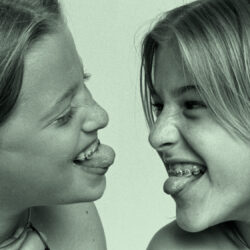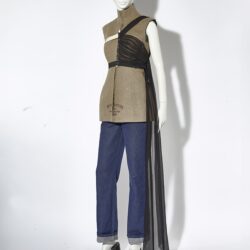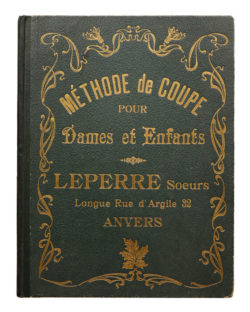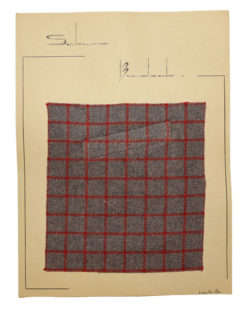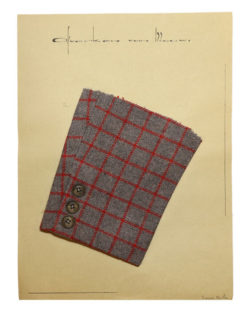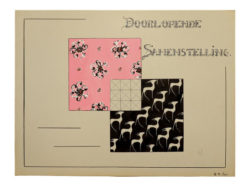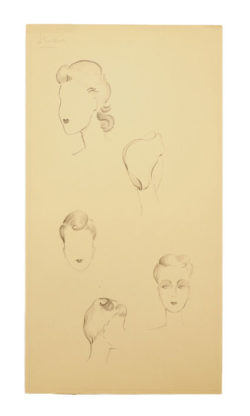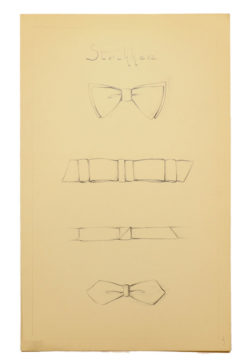Dressmaking: Course Materials

The handicrafts that played such an important role in the education of girls were not limited to embroidery and sewing exercises, neither did dressmaking courses only cover sewing techniques. Pupils learned to analyse fashionable garments and to make patterns for them. They learned to draw fashion illustrations and studied historic costumes. All of this can still be found in the course materials used at dressmaking schools.
ALBUMS D’OUVRAGE
At some schools, pupils collected their handicraft exercises in needlework albums, or albums d’ouvrage. In 1865, for example, Mlle Tessaro, a pupil at the Pensionnat des Dames de l’Union du Sacré Cœur in Hoegaarden, made an album of various stitching, knitting, crochet, embroidery and darning exercises which she attached to blue paper. In the album, we also see a range of miniature garments, which allowed her to practice dressmaking techniques at scale: inserting a sleeve, finishing a collar, and using pleats and darts to create volume.

Another handsome example is an early 20th-century album by Maria Bellens-Verreydt, filled with needlework and embroidery techniques for making underwear. These exercises reveal an evolution from basic skills to more complex techniques: from simple chain stitches to finely embroidered initials and motifs, from making buttonholes to inserting lace, from embroidering on cotton to embroidering on silk. It is also interesting that some exercises are left at various stages of completion, helping us today to understand more about the techniques employed.


By the middle of the 20th century, needlework albums were still popular in dressmaking education. Andrea De Block and Emmy Van Aken each filled their respective albums with exercises for smocking, buttonholes, sequin embroidery, cuffs, various pockets, incrustations and decorative stitching. Moreover, Emmy Van Aken added drawings to a number of her exercises, illustrating the application of a given technique on a garment.
CAHIERS DE COUPE
Drawing and cutting patterns was another essential part of dressmaking education. In a so-called cahier or album de coupe (a pattern notebook) the students kept notes about drafting and adapting patterns for fashionable articles of clothing. A number of examples from the MoMu collection were made around 1900 by Maria Jacobs, Rachel Keulenaer and Louise Legrand. These notebooks are not only a fascinating source about dressmaking education, but also about dominant fashions of this period.

pattern study for bodice with high collar

Rachel Keulenaer, pattern study for bodice with high collar, 1904 pattern study for a trumpet-shaped skirt or jupe cloche

Rachel Keulenaer, pattern study for a trumpet-shaped skirt or jupe cloche, 1904 pattern study for a trumpet-shaped skirt or jupe cloche

Maria Jacobs, pattern study for a trumpet-shaped skirt or jupe cloche, 1890-1910 pattern study for leg-of-mutton or gigot sleeve

Maria Jacobs, pattern study for leg-of-mutton or gigot sleeve, 1890-1910 pattern study for leg-of-mutton or gigot sleeve

Louise Legrand, pattern study for leg-of-mutton or gigot sleeve, 1907-08 pattern study for a flounced petticoat

Louise Legrand, pattern study for a flounced petticoat, 1907-08

THE SAILOR SUIT
Sailor suits for young children were a fashion trend that originated in the mid-19th century, when the then four-year-old Prince Albert Edward, son of Queen Victoria, wore such an outfit on a visit to Ireland. The shirt with the rectangular sailor collar became a much-loved part of children's wardrobes through to the early 20th century.



DRESSING GOWN WITH WATTEAU PLEAT
During the last decades of the 19th century, luxurious dressing gowns and tea gowns were very popular. These garments were meant to be worn at home and often included historic elements, such as the Watteau pleat, inspired by the 18th-century robe à la française. Well-to-do ladies wore this type of garment during the afternoon, for example to receive visitors for five o’clock tea.

Where the mid-20th century is concerned, the notebooks kept by Andrea De Block and Emmy Van Aken are once again an interesting source. In their notes and drawings, we recognize elements from the fashions of those years: rounded shoulders, a cinched waist and a wide, voluminous skirt – the silhouette popularized by Christian Dior's New Look – as well as tailored suits and close-fitting pencil skirts. Coats and jackets had broad collars and lapels, and either fell loose from the shoulders or were belted around the waist to expand around the wide skirts.
TAILORING FOR MEN
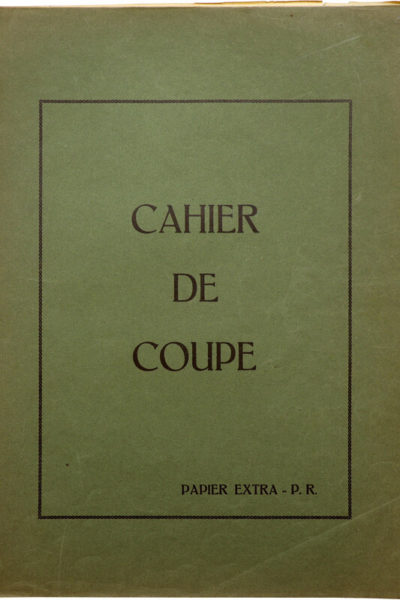

The MoMu collection contains not only course materials from dressmaking education for girls, but it also includes notebooks from men’s tailoring classes. Here, unlike the courses for girls, we do not see meticulously finished samplers or albums d’ouvrage. Nonetheless, learning a range of sewing techniques was an important part of the curriculum. Pupils took due note of various stitches – such as pick, cross, chain and buttonhole stitches – and undoubtedly practiced them on scraps of fabric, but without adding them to their notebooks. The many patterns in these notebooks show us the diversity of the various garments they learned to produce: from classic trousers to such variations as knickerbockers and riding breeches, from classic single or double-breasted suit jackets to waistcoats, shirts, tuxedo jackets and dress suits.
In the notes kept by René Sips, a pupil at the Frédéric Ozanam school in the Kammenstraat in Antwerp, we read a definition of the profession of tailor, with a description of the studio, materials and tools required, as well as the correct positions in which to work, including the cross-legged tailor’s seat (in Dutch kleermakerszit), in which one sits on the table with the garment one is working on laid across the knees.

FASHION ILLUSTRATIONS
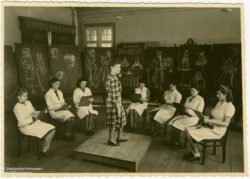
Not only fine sewing and skilled pattern drawing and cutting were considered important skills in dressmaking education, but so too was the representation of fashionable silhouettes. Girls’ dressmaking education, unlike that of boys, gradually increased the emphasis on fashion illustration. An anonymous folder dating from the 1920s, for example, contains illustrations of the fashions of the time, characterized by straight lines and loose-fitting, tunic-like dresses. Drawings from throughout the 20th century show exercises in copying fashion prints, studies of the human body and studies of materials, as well as designs for garments and their embellishment.
Photograph at the top of the page:
The sewing department at the vocational school for girls, Bouwmeestersstraat 3, Antwerp, 1948
FelixArchief/Antwerp City Archives, 686#45
Author: Dries Debackere
